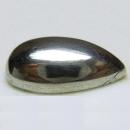|
|
||||||||||||||||
|
||||||||||||||||
|
||||||
|
|
|
|
Antimony
|
|
| | |
| Discovered in ancient times; IMA status: Valid (pre-IMA; Grandfathered) | ||
|
| ||
|
Chemistry |
|
|
| |
|
Sb | |
|
|
Antimony (native element) |
|
Molecular Weight: |
121.75 gm |
|
Composition: |
Antimony |
100.00 % |
Sb | ||
|
|
|
100.00 % |
|
|
|
|
|
|
||||
|
Classification |
|
|
| |
|
Elements | |
|
1/B.01-30 | |
|
|
1 : ELEMENTS (Metals and intermetallic alloys; metalloids and nonmetals; carbides, silicides, nitrides, phosphides)
|
|
Related to: |
Arsenic Group. Antimony-Arsenic Series. |
|
Members of Group: |
Arsenic Group: Antimony, Arsenic, Bismuth |
|
Varieties: |
Bismuthian Antimony |
|
Synonyms: |
Native Antimony, ICSD 64695, PDF 35-732 |
|
|
|
|
Crystal Data |
|
|
|
|
|
Prominent {0112} yields pseudocubic crystals, to 1 cm; also rounded and hoppered; commonly massive or cleavable lamellar, also radiated; may be botryoidal or reniform with granular texture. |
|
|
On {0114}, commonly forming complex groups, fourlings, sixlings; also polysynthetic twins. |
|
|
|
|
|
Physical Properties |
|
|
|
|
|
Perfect on {0001}, distinct on {1011}, imperfect on {1014}, indistinct on {1120}. |
|
|
Irregular/Uneven |
|
|
Brittle |
|
|
3.0 - 3.5; (Vickers: VHN100=50 - 69 kg/mm2) |
|
|
6.61 - 6.71 (g/cm3) |
|
|
None |
|
|
Not Radioactive |
|
|
|
|
|
Optical Properties |
|
|
|
|
|
Tin-white, light gray to a steel gray which can tarnish to darker grays |
|
|
Opaque |
|
|
Metallic |
|
|
R1–R2: (400) 71.6–74.1, (420) 72.3–75.1, (440) 72.9–75.8, (460) 73.6–76.6, (480) 74.2–77.3, (500) 74.6–77.8, (520) 74.7–77.9, (540) 74.5–78.0, (560) 74.0–77.7, (580) 73.3–77.1, (600) 72.3–76.6, (620) 71.4–76.0, (640) 70.3–75.3, (660) 69.2–74.8, (680) 68.4–74.4, (700) 67.7–74.2 |
|
|
0.00 (opaque) |
|
|
n/a |
|
|
Very feeble |
|
|
Weak in air, lively in oil |
|
|
|
|
|
Occurances |
|
|
|
|
|
Geological Setting: |
In hydrothermal Sb–Ag veins. |
|
Common Associations: |
Silver, Stibnite, Allemontite, Sphalerite, Pyrite, Galena, Quartz |
|
Common Impurities: |
As |
|
Type Locality: |
Sala Silver Mine, Sala, Västmanland, Sweden (mondern times). Known in ancient Egypt as early as 3100 BC. |
|
Year Discovered: |
Discovered in ancient times. Known in ancient Egypt as early as 3100 BC. |
|
View mineral photos: | |
|
|
|
|
More Information |
|
|
|
|
|
| |
|
|
|
|
Antimony rarely forms in its elemental state and is far more common in sulfides and sulfosalts such as Bournonite, Jamesonite, Stibnite, Tetrahedrite and Boulangerite. It is also found in some oxides such as Valentinite, Stibiconite and Sénarmontite. Antimony compounds have been known since ancient times and were used for cosmetics in ancient Egypt. Metallic Antimony was also known but it was erroneously identified as lead. It was first isolated and described in 1540 by Vannoccio Biringuccio. The largest uses for metallic Antimony are as an alloying material for lead and tin and for lead antimony plates in lead-acid batteries. Alloying lead and tin with Antimony improves the properties of the alloys wich are used in bullets, solders and bearings. Antimony is now also being used in microelectronics. The modern day type locality for Antimony is listed as Sala Silver Mine, Sala, Västmanland, Sweden but Antimony was known in ancient Egypt as early as 3100 BC. Antimony was named from the Arabic, al-uthmud, which became the Medieval Latin, antimonium; which was originally applied to Stibnite, the sulfide of Antimony. The etymology is somewhat uncertain. One path of the name origin is that antimonium came from avτίμοναχός, or anti-monachos, meaning "anti monks", literally "monk-killer" because early alchemists were often monks and that Antimony is poisonous. Another popular etymology possibility is the Greek word antimonos meaning "against aloneness" which could mean "not found unalloyed" in allusion to the fact that Antimony is rarely found in its elemental state. There
are numerous localities for Antimony: In the USA,
from South Riverside, Riverside County; in kg masses
from Erskine Creek, Kern County, California. From Príbram,
Czech Republic. At St. Andreasberg, Harz Mountains,
Germany. In France, from Allemont, Isère. At
Sarrabus, Sardinia, Italy. From Sala, Västmanland,
and in the Vena mines, near Askersund, Örebro,
Sweden. At Kalliolampi, Nurmo, and near Seinajöki,
Finland. At Broken Hill, New South Wales, Australia.
From Huasco, Tarapacá, Chile. In Canada, at South
Ham, Wolfe County, Quebec. At Arechuybo, Chihuahua,
Mexico. |
|
|
We
have not photographed our Antimony gems yet. Please
check back soon. |
